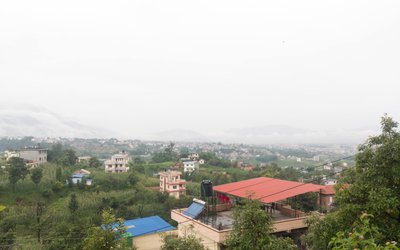Disaster is in the air
Around the world, rainfall is growing increasingly unpredictable and erratic, leaving many regions vulnerable to more intense and more frequent water-induced disasters, including floods and landslides. South Asia ranks right up at the top of the list of most affected regions. Already 50 million people of the 1.8 billion strong population in the Ganges River Basin suffer each year, and the projected cost of addressing such disasters in 2030 is USD 215 billion.
True, deaths and loss of assets are on the decline, but, really, South Asian nations are neither structurally nor non-structurally prepared for the predicted onslaught. Take Nepal. Here, water-induced disasters cause on average 300 deaths and shave 1.5% off of the GDP every year. The monsoon season is a particularly frightening time, as poor households watch fearfully for their houses to be swallowed by a flood or crushed by a landslide. Human and economic losses are great and growing.
A recurrent Nepali tragedy
The impacts of water-induced disasters are not limited to statistics on deaths and dollars. Every disaster means dozens of loved ones dead and injured and hundreds of homes and infrastructures, including schools, bridges, government offices, hydropower stations, irrigation projects, and commercial enterprises damaged and destroyed. Such disasters also increase long-term poverty levels by damaging agricultural land and crops, thereby increasing food insecurity; displacing people; and interrupting livelihoods.
Devastation of this scale is an annual affair. According to Nepal’s DRR Portal, 141 water-induced disaster incidents occurred between 5 June and 10 July, 2022. Of the total 77 districts, nine districts experienced floods, 31 districts landslides and 51 districts heavy rainfall. Altogether 114 local governments were forced to address disasters that claimed the lives of 23, severely affected more than 168 families and cost NPR 61.4 million. All in just 35 days.
Cumulatively over the last decade, the impact is yet more shocking. Between 2011 and 2021, in 5,825 water-induced disasters; 2,362 died, 880 went missing, 1,646 were injured, 78,811 families suffered, and NPR 19 billion were lost. Such loss is not evenly distributed. Just 23 districts are at high risk of floods and 31 districts at high risk of landslides.
Monsoon facts
Nepal’s lack of preparation is somewhat puzzling. We know the facts; the meteorology is no secret. The average annual rainfall during the monsoon (13 June to 23 September) is roughly 1,358.5 mm, 80% of the yearly total, and the average number of rainfall days is 105 to 110.
One twist in the pattern does exist, however: of late, the monsoon has withdrawn later than usual. And this year it arrived a week early, on 5 June. While rainfall amounts do fluctuate, the Department of Hydrology and Meteorology (DHM), can and does make predictions that could be used for better preparation. This year, for example, rainfall is to be normal to above normal in large parts of the country, and slated to total up to 1680 mm.
Why the persistent problem
Both natural phenomena and human activity are responsible for water-induced disasters. In the hills, high intensity rainfall loosens landmasses, making slopes vulnerable to failure. Severe deforestation and poorly planned civil engineering works, both the fault of human negligence, are then all it takes to trigger an actual slide. The 2015 earthquake is case and point. Google images from 2015 reveal the high concentration of landslides along the Mahabharat and Churia ranges in earthquake-affected districts. Other triggers include heavy rains, avalanches, dam bursts, and flash floods.
Floods in the Terai, in contrast, are triggered by the haphazard extraction of riverbed materials from the Churia. In addition, the dykes India has constructed close to the border obstruct the regular flow of flood water, resulting in inundation in Nepal lasting several days to weeks. Embankments and elevated highways built near the Nepali border with Uttar Pradesh and Bihar also exacerbate the impacts of floods.
Initiatives: too little, too late
Government, non-government, private and humanitarian agencies have tried to manage water-induced disasters and even developed many good practices but are stymied by significant challenges.
Policies on paper hard to put in practice. The Disaster Risk Reduction National Policy (2018) focuses on floods, inundation and climate change-adaptive agricultural systems in a bid to build resilience and the National Water Plan (2002–2027) incorporates integrated water resource management, including water-induced disaster management, risk and vulnerability mapping, disaster networking, and information system improvement. The goals of the latter policy include establishing a national flood forecasting and early warning system by 2017 and limiting social and economic losses due to water-induced disasters to levels experienced in developed countries by 2027. Because of the lack of supportive institutions, however, these goals will be hard to realize.
Similarly, while the 2016 the Water Induced Disaster Management Policy promoted a decentralized river basin-scale approach to flood risk management, the required coordination with provincial and local government agencies has eluded the nation. In 2018, the Water and Energy Commission Secretariat also sought to promote integrated river basin management by outlining the required institutional framework. It did develop river basin organizations, but without a legal framework to functionally empower and financially sustain them and with the constraint of overlapping government jurisdictions, it found adopting government strategies challenging. The lack of financial backing for efforts makes matters worse.
Plans still piecemeal. While the government’s amended monsoon preparedness and response plan helped develop and strengthen indicator-based disaster-resilience measurement tools for communities, on the ground, the spirit of community-based disaster risk management is weak. In addition, flood vulnerability in the Terai has increased with the influx of migrants and the resultant profusion of haphazard settlements that disrupt natural drainage. Coordination of plans is poor, technical and financial resources limited, and the sharing and implementation of good practices and learning minimal. Given that most plans merely duplicate efforts, they need to be harmonized into one all-encompassing effort.
Mapping minimal and inadequate. Technical teams have been working with governments to use satellites and drones to add more depth to traditional on-the-ground observations of unstable mountainsides, but progress in consolidating information from countrywide multi-hazard risk assessments is slow. Unfortunately, too, VisRisk: Visual Systemic Risk Analytics Platform is not yet used adequately to identify risks and vulnerabilities before crafting the plans.
Project learning insufficiently applied. The Nepal government has partnered with the ADB, World Bank, UNDP, Zurich Foundation and other agencies to manage floods since 2009, and the Australian and Finnish governments and development agencies such as the World Bank, FAO, UNDP, European Union, JICA, and USAID have contributed to water management since 2006. The good practices and learning generated by these nodal agencies are not reflected on the ground, however, because knowledge management mechanisms are poor.
That said, the Nepali government and 17 development partners did endorse the Kathmandu Declaration and 10-year GRID Strategic Action Plan committing to green, resilient and inclusive development aimed at coping with the slow-moving catastrophe of melting glaciers and severe and unseasonal storms. Up to USD 4.2 billion will be provided in potential future support in addition to $3.2 billion already committed.
Satellite surveillance is slow. Pilot projects using satellites to monitor the mountainous regions of Nepal, Bhutan and India in partnership with the identified slopes subject to constant deformation, an early sign of landslides. It helped to investigate the causes of the Melamchi disaster of last year. The information gained was critical to understanding the risks of new landslides and planning building back better. But overall monitoring mechanisms are still slow.
Risk warnings inadequately systematized. Nepal effectively communicates hydrological-meteorological hazards by providing real-time and three-day rolling information using standard operating procedures (SOPs) for early warning systems (EWSs). These SOPs provide a coherent framework for future investment and offer significant benefits for reducing vulnerabilities and losses by giving communities enough time to respond. Nepal Telecom and Ncell play significant roles in disseminating flood warnings and extreme weather alerts through SMSs and phone calls. Despite these advancements, the National EWS Action Plan (2013) has not been enacted, there is no policy to systematize EWSs, and trans-border weather and river monitoring and EWS need strengthening.
Regional cooperation too limited: Despite the common challenges faced by the South Asian countries, regional cooperation for disaster management has been limited to a bit of debate and discourse due to geopolitical tensions and limited technical capacity and financial resources. While each country has disaster-related policies, limited commitment and resources inhibits their implementation.
All is not lost
Adopting the following structural and non-structural approaches can reduce the impacts of water-induced disasters.
- Strengthen regional weather and river monitoring and EWSs. Addressing the regional implications of disasters in Nepal requires regional coordination and collaboration as well as trans-border weather and river monitoring and sharing of information. To do so, the existing flood forecasting system and EWSs needs to be upgraded. In addition, community awareness of and capacity for flood response needs to be improved by modernizing Nepal’s observation network, extending it into the High Himalaya and making its forecasting more accurate and timely. A stronger water monitoring and water auditing system needs to be in place so that Ganges-Brahmaputra-Meghna flood forecasting can provide warning up to 16 days in advance. The ‘common alert protocol’ should be used so that emergency messages can be disseminated over a wide variety of systems.
- Establish and strengthen EOCs. Local governments need to regulate EOCs, eliminating duplication and enhancing coordination, communication, and information management, as well as strengthen their technical capacities using software and hardware packages that enable them to disseminate timely impact-based early warning messages to last-mile populations. EOCs must develop early warning and communication plans that consider the needs, capabilities, and preferences of vulnerable groups, including women, children, youths, persons with disabilities, senior citizens, and indigenous groups.
- Improve small-scale infrastructure. All sorts of improvements should be made, including raising plinth levels, improving drainage systems, repairing floodwalls, and maintaining evacuation routes. In addition, bioengineering techniques, terracing, and dyke, floodway and dam construction should be used to manage excess water. River training and integrated watershed management efforts like water source protection and gully control, need support, as does the development of GIS-based flood hazard maps. All three tiers of government must also increase their investment in integrated disaster risk management and improve access to disaster risk finance for transferring risks.
- Share experiences. South Asian countries should organize learning-cum-review workshops under the leadership of national institutions like Nepal’s National Disaster Risk Reduction and Management Authority and improve their tools and approaches for integrated disaster risk management by sharing and adopting others’ good practices and learning. The technical capacities of institutions like the SAARC Disaster Management Centre, ICIMOD, and RIMES, need to be strengthened to support this effort.
- Operationalize learning. Learning needs to be applied in order to improve structural and non-structural measures, from infrastructure development and river basin management to preparing multi-hazard risk profiles, signing river water sharing agreements, developing forecasting and EWS, and implementing risk-sensitive land-use planning.
(Dr. Gautam is an Independent Researcher and Consultant. He is associated with National Disaster Risk Reduction Centre (NDRC) Nepal as Senior Research Fellow and HADRI/Western Sydney University as Adjunct Fellow. He can be reached through drrgautam@gmail.com)
- Renewable Energy-Sector Policy Initiatives And UNDP’s Role In The Pacific Region: The Path Ahead
- Mar 04, 2024
- Operationalization Of Nepal’s National Adaptation Plan: Institutionalizing A Monitoring, Review, And Reporting System Is Crucial
- Jan 09, 2024
- Building A Pacific Region Resilient To Climate Change: A Seven Step Approach Is Urgently Required
- Jan 04, 2024
- The “Safe School” Campaign: Is Nepal moving In The Right Direction?
- Sep 12, 2022
- Nepal’s DRRM Policy Landscape: Well On The Way To Making Nepal Ready And Able To Respond To Disasters
- Aug 22, 2022

















